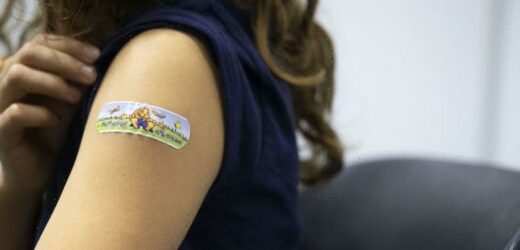Parents yet to vaccinate their children against COVID-19 are being urged not to wait amid a rise in cases among school students as new data shows side effects to the vaccine are overwhelmingly mild, and occur at lower rates than were predicted in clinical trials.
Children aged five to 15 are reporting fewer common side effects – which include a sore arm, fatigue, headaches and muscle pain – after their mRNA COVID vaccinations than those reported in clinical trials, data from national vaccine safety surveillance system AusVaxSafety shows.
An analysis of 392,268 survey responses from parents of children vaccinated between July 2021 and May 2022 showed roughly a quarter of five- to 11-year-olds reported at least one side effect within three days of their Pfizer vaccines (25 per cent following their first dose, and 28 per cent following their second).
Among 12- to 15-year-olds who received Pfizer, one in three reported at least one side effect following their first dose (32 per cent), and half reported side effects after their second (49 per cent). One in three children in that age group who had the Moderna vaccine reported side effects after their first dose (34 per cent), and two in three following their second (64 per cent).
The survey responses were provided by parents via SMS or email.
A sore or itchy arm, redness and swelling at the injection site, fatigue, headaches and joint or muscle pain were the most common side effects among both age groups and usually faded away within a day, the researchers from the National Centre for Immunisation Research and Surveillance (NCIRS) reported.
A child after receiving a COVID vaccination.Credit:AP
Associate Professor Nick Wood, associate director of clinical services and vaccine safety at the NCIRS and lead author of the analysis, said the rate of side effects was “probably a third lower” than were observed during clinical trials.
“When you’re in a clinical trial, you’re more closely scrutinised … [but] this data shows how it is experienced in the real world,” Wood said.
Just 0.3 per cent of five- to 15-year-olds sought medical help for their side effects, and only 7 per cent reported that their routine activities were affected.
Side effects were slightly higher in children with chronic medical conditions, which might reflect closer observation by their parents. The researchers suggested the rate of side effects could be even lower, with parents more likely to complete the survey if they noticed side effects.
Wood said the reactions experienced by children were similar to adults, but incidences were fewer. For example, 53 per cent of adult Pfizer recipients reported an adverse event after dose two, and 21 per cent missed routine activities such as work or study.
About 2.2 million children aged 5 to 15 (53 per cent) have received at least one dose of a COVID vaccine and 1.9 million (40 per cent) have received their second. Wood said he hoped parents yet to vaccinate their children would use the survey data to inform their decision.
“Forewarned is forearmed … [so] here is data to support their decision-making about the vaccine,” Wood said.
Professor Robert Booy, an infectious diseases paediatrician at the University of Sydney, said the results confirmed what was being seen abroad: that younger children were experiencing fewer side effects from the vaccines.
There were no reported cases of myocarditis (inflammation of the heart) or pericarditis (swelling of the tissue surrounding the heart) in the survey data, however, the Therapeutic Goods Administration has received four reports of likely myocarditis and six of likely pericarditis in children aged five to 11 and about 700 likely myocarditis and 1050 likely pericarditis cases among the 12 to 17 age group, mostly in boys.
No child or adolescent has died from a COVID-19 vaccine in Australia.
“The concern we had with older children and teenagers was myocarditis, but the reports are reassuring that this is considerably rare,” Booy said.
With the start of the school term, coronavirus infections have increased in children and teenagers, data from NSW Health’s latest surveillance report shows.
There were more than 4100 cases in children aged five to nine, up from 2600 the previous week, and more than 8500 cases in those aged 10 to 19, up from 5200.
The findings, which have not been peer-reviewed, were published on Thursday on medRxiv.
Stay across the most crucial developments related to the pandemic with the Coronavirus Update. Sign up for the weekly newsletter.
Most Viewed in National
From our partners
Source: Read Full Article



